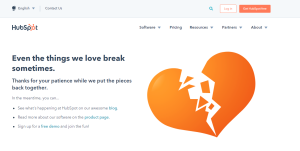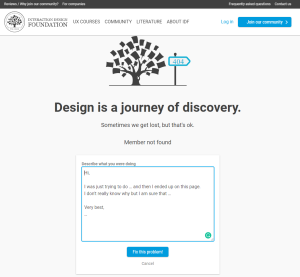
By Brittnay Bell
While you never want your visitors to stumble upon a broken link on your website, a 404 error message page can be an opportunity for you to use creativity and wit to further connect with your audience. Plenty of companies use clever 404 pages to show off their brand personality and incorporate some of the newest UX features on their website. Check out some of my favorites below.
- Use a call to action to build leads, collect emails or RSVP for an event or seminar

Hubspot does a great job of providing options for users who have clicked on a broken link. The key advantage to this 404 page is that it keeps users on their website and increases clickthrough so that the visitor isn’t completely lost. Call to actions don’t have to lead to other pages of your website, consider updating your 404 page with relevant information like a seminar you’re hosting, invite them to schedule time with your team for a demo or consultation, or signup for your company’s newsletter.
- Gather information from users

Interaction Design Foundation uses their 404 page to get to the root of what is causing the error message for their users. Not only are they collecting user information, but they are also receiving valuable information that could help them fix the problem so that future users do not experience broken links.
- Have fun and be cheeky

A little humor can pull anyone through an annoying situation, take the New Yorker for example. Your 404 message is a great place to evoke a humorous brand personality, even more so than the rest of your website. Using trendy memes, cartoons and even video spoofs of errors are great ways to bring your brand’s personality to life.
- Keep it simple and make good use of white space

You don’t have to try so hard with a 404 page. Modcloth’s 404 page provides a list of alternative pages related to the link a user was trying to access. Further, they offer ways for a user to get into contact with their team if the suggested links aren’t what the user was looking for. Offering alternatives for a user to get back on track is a great way to ensure that they don’t leave your site altogether.
- Entertain and engage
Heyzap (recently acquired by Fyber) provides a little stress relief to the lost user by incorporating a game on their 404 page. While you may not have the development chops to build a game, consider utilizing an interactive element on your 404 page. This could be something as simple as an image that moves when the user’s mouse scrolls over it, or a video in the background.
Don’t lose users with a terribly built, boring, run-of-the-mill error page. Make your 404 page a central part of your website development conversation. Broken and missing links are never fun, and we hope that users never experience them, but they can also be a great opportunity to connect with users in a meaningful way.
